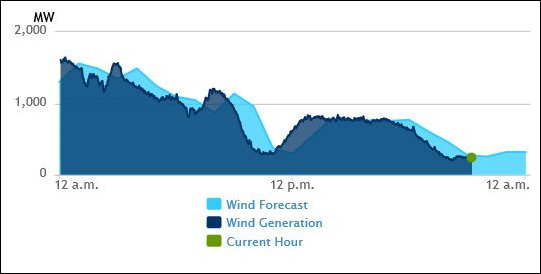The great thing about wind power is that the fuel is free. The bad thing about wind power is that you can’t count on getting it when you want it. Wind power may be an economically competitive source of electric power in parts of the country, like the plains states, where wind is strong and steady, but it’s not so competitive where its output is intermittent.
Yesterday afternoon, I captured this image from the PJM Interconnection website, which shows the fluctuations in wind generation compared to forecasts over 24 hours. (Both Dominion Virginia Power and Appalachian Power Co. are integrated in the PJM regional grid.) Here is the explanation that PJM provides:
Because wind is an intermittent resource, it requires its own forecasting and monitoring methods to plan for its reliability. This graphic chart displays both instantaneous power (in megawatts) being produced and forecasted power for every five minutes. It is updated hourly. The data is measured at each wind farm every minute and then is aggregated for this tool. Dispatchers use this display to monitor trends in wind power production.
The fact that PJM’s service territory spans parts of 13 states and the District of Columbia helps even out the power output. Local fluctuations sometimes cancel each other out. Even so, wind output varied from roughly 200 megawatts to 1,600 megawatts over the 24-hour period. In this particular day, wind turbines were cranking out the energy when it was needed least, during the night, and took a steep dive in the late morning when electricity demand was high and rising.
If wind power can’t be relied upon to produce electricity when needed, or at the very least on a predictable basis, the electric grid needs substantial backup capacity, maintained at great expense, to fill in the gaps. That’s why, over and above the local Not In My Back Yard resistance to wind farms, on-shore wind power doesn’t make much sense in Virginia. Even if Virginia wind power can crank out electricity competitively on a stand-alone basis, measured by the cost per kilowatt hour, basis, that’s not especially helpful to an integrated grid designed for system-wide reliability.
Solar energy is a very different story, as I will explain later today. Solar is intermittent as well, but it is intermittent within narrower parameters than wind. Solar plants generate zero electricity during the night, when electricity demand is lowest, and they reach maximum capacity during the afternoon, which coincides with peak electricity demand. My sense is that solar will play a much bigger role in Virginia’s energy future than wind.
— JAB
(Hat tip: TomH)



